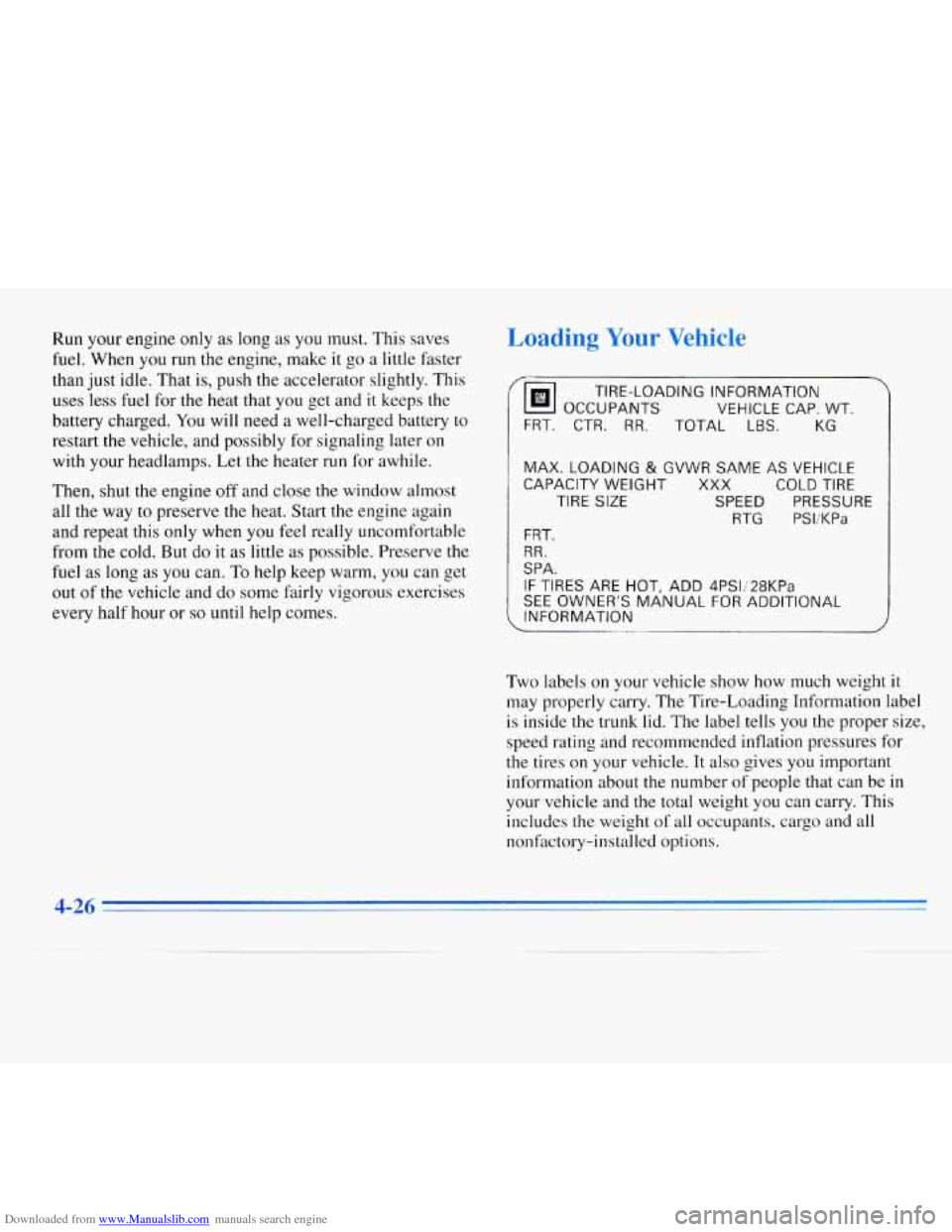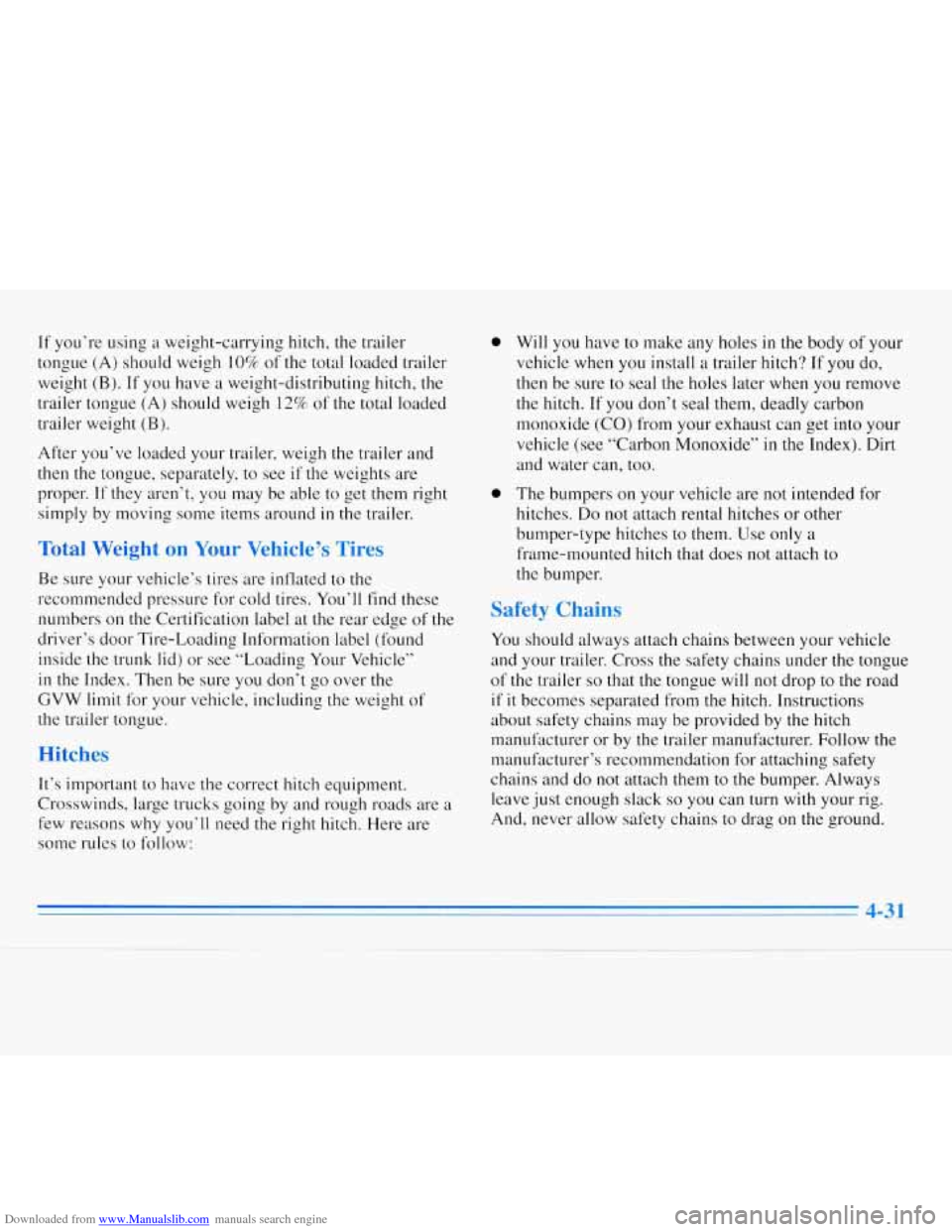1996 CHEVROLET MONTE CARLO run flat
[x] Cancel search: run flatPage 93 of 340

Downloaded from www.Manualslib.com manuals search engine Door Storage Compartments
Each of the doors has a storage compartment.
Center Console
To open the storage area, press the button and lift the
cover. The console has a cassette and
CD storage bin
and a cupholder. To use the cupholder for large cups,
remove the insert.
Convenience Net (Option)
ii, ’
Your vehicle may have a convenience net. You’ll see it
just inside the back wall
of the trunk.
Put small loads, like grocery bags, behind the net. It can
help keep them from falling over during sharp turns or
quick starts and stops.
The net isn’t for larger, heavier loads. Store theln
in the
trunk as far forward as
you can.
You can unhook the net so that it will lie flat when
you’re not using it.
Page 162 of 340

Downloaded from www.Manualslib.com manuals search engine Run your engine only as long as you must. This saves
fuel. When you run the engine, make it go a little faster
than just idle. That is, push the accelerator slightly. This
uses less fuel for the heat that you get and
it keeps the
battery charged. You will need
a well-charged battery to
restart the vehicle, and possibly for signaling later
on
with your headlamps. Let the heater run for awhile.
Then, shut the engine off and close the window almost
all the way to preserve the heat. Start the engine again
and repeat this only when you feel really uncomfortable
from the cold. But
do it as little as possible. Preserve the
fuel as long as you can. To help keep warm, you can get
out of the vehicle and do some fairly vigorous exercises
every half hour or
so until help comes.
Loading Your Vehicle
%I OCCUPANTS VEHICLE CAP. WT.
TIRE-LOADING INFORMATION
FRT. CTR. RR. TOTAL
LBS. KG
MAX. LOADING & GVWR SAME AS VEHICLE
CAPACITY WEIGHT
XXX COLD TIRE
TIRE
SIZE SPEED PRESSURE
RTG PSI/KPa
FRT.
RR.
SPA.
IF TIRES ARE HOT, ADD 4PS1;28KPa
SEE OWNER’S MANUAL FOR ADDITIONAL
INFORMATION
Two labels on your vehicle show how much weight it
may properly carry. The Tire-Loading Information label
is inside the trunk lid. The label tells you the proper size,
speed rating and recommended inflation pressures for
the tires on your vehicle. It also gives you important
information about the number
of people that can be in
your vehicle and the total weight
you can carry. This
includes the weight
of all occupants, cargo and all
nonfactory-installed options.
4-26
Page 167 of 340

Downloaded from www.Manualslib.com manuals search engine If you’re using a weight-carrying hitch, the trailer
tongue (A) should weigh 10% of
the total loaded trailer
weight
(B). If you have a weight-distributing hitch, the
trailer tongue
(A) should weigh 12% of the total loaded
trailer weight
(B).
After you’ve loaded your trailer, weigh the trailer and
then the tongue, separately, to see
if the weights are
proper.
If they aren’t, you may be able to get them right
simply by moving some items around
in the trailer.
Total Weight on Your Vehicle’s Tires
Be sure your vehicle’s tires are inflated to the
recommended pressure for cold tires. You’ll find these
numbers on the Certification label at the rear edge of the
driver’s door Tire-Loading Information label (found
inside the trunk lid) or see “Loading Your Vehicle”
in the Index. Then be sure you don’t go over the
GVW limit for your vehicle, including the weight of
the trailer tongue.
Hitches
It’s important to have the correct hitch equipment.
Crosswinds, large trucks going by and rough roads are
a
few reasons why you’ll need the right hitch. Here are
some rules to follow:
0
a
Will you have to make any holes in the body of your
vehicle when you install a trailer hitch? If you do,
then be sure to seal the holes later when you remove
the hitch. If you don’t seal them, deadly carbon
monoxide (CO) from your exhaust can get into your
vehicle (see “Carbon Monoxide”
in the Index). Dirt
and water
can, too.
The bumpers on your vehicle are not intended for
hitches.
Do not attach rental hitches or other
bumper-type hitches to them. Use only a
frame-mounted hitch that does not attach to
the bumper.
Safety Chains
You should always attach chains between your vehicle
and your trailer. Cross the safety chains under the tongue
of the trailer so that the tongue will not drop to the road
if it becomes separated from the hitch. Instructions
about safety chains may be provided by the hitch
manufacturer or by the trailer manufacturer. Follow the
manufacturer’s recommendation for attaching safety
chains and do not attach them to the bumper. Always
leave just enough slack
so you can turn with your rig.
And, never allow safety chains to drag on the ground.
Page 202 of 340

Downloaded from www.Manualslib.com manuals search engine Storing the Flat Tire and Tools
NOTICE:
Improperly tightened wheel nuts can lead to
brake pulsation and rotor damage.
To avoid
expensive brake repairs, evenly tighten the wheel
nuts in the proper sequence and to the proper
torque specification.
10. Don't try to put a wheel cover on your compact spare
tire, It won't
fit. Store the wheel cover in the trunk
until you have the flat tire repaired or replaced.
I NOTICE:
Wheel covers won't fit on your compact spare. If
you try to put a wheel cover on your compact
spare, you could damage the cover or the spare.
I
' A CAUTI(
I
Storing a jack, a tire or other equipment in the
passenger compartment
of the vehicle could
cause injury. In
a sudden stop or collision, loose
equipment could strike someone. Store all these
in the proper place.
After you've put the compact spare tire on your vehicle
you'll need to store the flat tire in your trunk. Use the
following procedure to secure the flat tire in the trunk.
Put the flat tire in the trunk
so the side that faces out
when it is on the vehicle is facing down. The full-size
tire will not fit down into the well. Place
it so the front is
in the well and the rear is out of the well.
5-30
Page 245 of 340

Downloaded from www.Manualslib.com manuals search engine 0 0
0
Underinflated tires pose the same danger
as overloaded tires. The resulting accident
could cause serious injury. Check all tires
frequently to maintain the recommended
pressure. Tire pressure should be checked
when your tires are cold.
Overinflated tires are more likely to be
cut, punctured or broken by
a sudden
impact
-- such as when you hit a pothole.
Keep tires at the recommended pressure.
Worn, old tires can cause accidents.
If your
tread
is badly worn, or if your tires have
been damaged, replace them.
Inflation - Tire Pressure
The Tire-Loading Information label which is on the
{inside of the trunk lid shows the correct inflation
pressures for your tires when they’re cold. “Cold”
means your vehicle has been sitting for at least three
hours or driven
no more than a mile.
NOTICE:
Don’t let anyone tell you that underinflation or
overinflation
is all right. It’s not. If your tires
don’t have enough air (underinflation), you can
get the following:
Too much flexing
Too much heat
Tire overloading
Bad wear
0 Bad handling
Bad fuel economy.
If your tires have too much air (overinflation),
you can get the following:
Unusual wear
Bad handling
0 Rough ride
0 Needless damage from road hazards.
6-37 ,
Page 333 of 340

Downloaded from www.Manualslib.com manuals search engine Ignition Switch ................................ 2-10
Illumination. Sustained Interior .................... 2-32
Inflation. Tire
.................................. 6-37
Inside Daymight Rearview Mirror
................. 2-33
Brakesystem
................................ 7-40
Exhaust Systems
............................. 7-40
Front-Wheel-Drive Axle Boot
.................. 7-40
Front-Wheel-Drive Axle Seal
.................... 7-40
Radiator and Heater Hose
...................... 7-40
Suspension
.................................. 7-40
Throttle Linkage
.............................. 7-40
Instrument Panel
............................... 2-38
Brightness Control
............................. 2-31
Cleaning .................................... 6-47
FuseBlock
.................................. 6-53
Interior Lamps 2-3
1
Inspections .................................... 7-40
Steering
.................................... 7-40
Cluster
..................................... 2-40
.................................
.................................... J ack. Tire 5-22
Jump Starting 5-2
...................................
Key Lock Cylinders Service ..................... 7-37
Key Reminder Warning
.......................... 2- 10
Keys ........................................... 2-1 Lamps
........................................ 2-30
Courtesy
.................................... 2-31
Interior 2-31 OnReminder
................................ 2-30
Latches, Seatback 1-5
Leaving Your Vehicle
............................. 2-3
Leaving Your Vehicle with
the Engine Running ....... 2-19
Lighter 2-36
Lights Air Bag Readiness
....................... 1-18, 2-43
Anti-Lock Brake System Active
............. 2-46, 4-8
Anti-Lock Brake System Warning
............ 2-45, 4-6
Charging System
............................. 2-43
.....................................
................................
.......................................
Brake System Warning ........... 1 ............. 2-44
Engine Coolant Temperature
.................... 2-46 - lnterior .............
Low Coolant Warning .
Low Oil Level Warning
Oil Warning
.........
Safety Belt Reminder . .
Security ............
Service Engine Soon . .
Loading Your Vehicle ... ..
........................ 2-31 ~-
........................ 2-47
........................ 2-51
........................ 2-50
.................... 1-7, 2-42
........................ 2-52
........................ 2-48
........................ 4-26
Locks
......................................... 2-3
Cylinders
................................... 7-37 -
Labels 4-26
Certification 4-27
Service Parts Identification
..................... 6-52
Tire-Loading Information
...................... 4-26
Vehicle Identification Number
................... 6-52
.......................................
.................................
9-5
..
1
Door ....................
Key Lock Cylinder Service .
Power Door .............
Steering Column Lock Check
Trunk
..................
Low Coolaat Warning Light . .
Low Oil Level Warning Light .
Lubricants and Fluids ........
Lubrication Service. Body ....
..................... 2-3
....................... 7.
...................... 2-3
................... 7-39
..................... 2-6
.................... 2-47
..................... 2-51
.................... 7-41
.................... 7-37
Page 337 of 340

Downloaded from www.Manualslib.com manuals search engine Thermostat .................................... 6-23
Tilt Steering Wheel
............................. 2-24
Time. Setting the
................................ 3-5
TireLoading
................................... 4-26
Tire-Loading Information Label
................... 4-26
BuyingNew
................................. 6-40
Tire Chains
.................................... 6-43
Tires
......................................... 6-36
Alignment
and Balance ........................ 6-42
Chains
..................................... 6-43
Changing a Flat
.............................. 5-22
Cleaning
.................................... 6-50
Compact Spare
............................... 5-33
Inflation
.................................... 6-37
Inflation Check
............................... 7-36
Inspection and Rotation
........................ 6-38
Loading
.................................... 4-26
Pressure
.................................... 6-37
Storing the Flat
............................... 5-30
Storing the Spare
............................. 5-32
Temperature
................................. 6-4 I
Traction .................................... 6-41
Treadwear
................................... 6-41
Uniform Quality Grading
....................... 6-40
Wear Indicators
.............................. 6-39
Wheel Replacement
........................... 6-42
When It’s Time for New
....................... 6-39
TopStrap
..................................... 1-33
TorqueLock
................................... 2-20
Torque, Wheel
Nut .............................. 5-29
TowingaTrailer
................................ 4-28
Towing Your Vehicle
............................. 5-7 Trailer
Brakes
Driving
Driving
Hitches
..................................... 4-32
onGrades
............................ 4-33
with ................................. 4-32
..................................... 4-31
Maintenance When Towing
..................... 4-34
Parking on Hills
.............................. 4-34
Safety Chains
................................ 4-31
Tongueweight
............................... 4-30
Total Weight on Tires
.......................... 4-31
Towing
..................................... 4-28
TurnSignals
................................. 4-33
Weight
..................................... 4-30
Transaxle Fluid. Automatic
....................... 6-16
Transmitters. Remote Lock Control
.................. 2-4
Transportation. Courtesy
.......................... 8-6
Trip Odometer
................................. 2-41
Trunk
......................................... 2-6
Lock
........................................ 2-6
Release. Remote
............................... 2-7
TTYUsers ..................................... 8-3
Turn Signal and Lane Change Signals
............... 2-25
Turn Signal/Multifunction Lever
................... 2-24
Turn Signals When Towing
a Trailer ................ 4-33
Underbody Flushin, o Service ..................... 7-39
Underhood Electrical Center
................. 6-56. 6-58
Underbody Maintenance
......................... 6-50
9-9